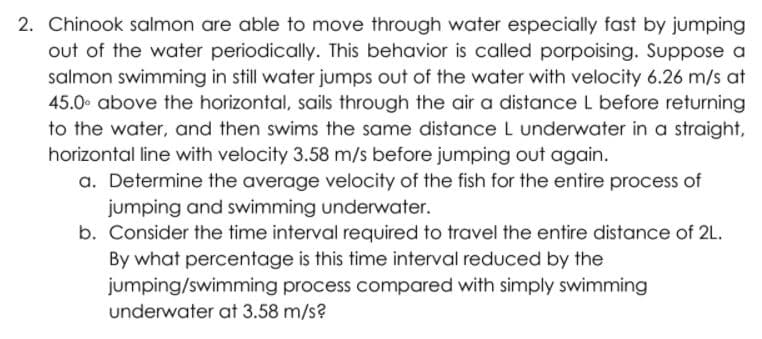Chinook salmon are able to move through water especially fast by jumping out of the water periodically. This behavior is called porpoising. Suppose a salmon swimming in still water jumps out of the water with velocity 6.26 m/s at 45.0 above the horizontal, sails through the air a distance L before returning to the water, and then swims the same distance L underwater in a straight, horizontal line with velocity 3.58 m/s before jumping out again. a. Determine the average velocity of the fish for the entire process of jumping and swimming underwater. b. Consider the time interval required to travel the entire distance of 2L. By what percentage is this time interval reduced by the jumping/swimming process compared with simply swimming underwater at 3.58 m/s?
Chinook salmon are able to move through water especially fast by jumping out of the water periodically. This behavior is called porpoising. Suppose a salmon swimming in still water jumps out of the water with velocity 6.26 m/s at 45.0 above the horizontal, sails through the air a distance L before returning to the water, and then swims the same distance L underwater in a straight, horizontal line with velocity 3.58 m/s before jumping out again. a. Determine the average velocity of the fish for the entire process of jumping and swimming underwater. b. Consider the time interval required to travel the entire distance of 2L. By what percentage is this time interval reduced by the jumping/swimming process compared with simply swimming underwater at 3.58 m/s?
College Physics
11th Edition
ISBN:9781305952300
Author:Raymond A. Serway, Chris Vuille
Publisher:Raymond A. Serway, Chris Vuille
Chapter3: Motion In Two Dimensions
Section: Chapter Questions
Problem 18P: A fireman d = 50.0 m away from a burning building directs a stream of water from a ground-level fire...
Related questions
Concept explainers
Topic Video
Question

Transcribed Image Text:Chinook salmon are able to move through water especially fast by jumping
out of the water periodically. This behavior is called porpoising. Suppose a
salmon swimming in still water jumps out of the water with velocity 6.26 m/s at
45.0 above the horizontal, sails through the air a distance L before returning
to the water, and then swims the same distance L underwater in a straight,
horizontal line with velocity 3.58 m/s before jumping out again.
a. Determine the average velocity of the fish for the entire process of
jumping and swimming underwater.
b. Consider the time interval required to travel the entire distance of 2L.
By what percentage is this time interval reduced by the
jumping/swimming process compared with simply swimming
underwater at 3.58 m/s?
Expert Solution
This question has been solved!
Explore an expertly crafted, step-by-step solution for a thorough understanding of key concepts.
This is a popular solution!
Trending now
This is a popular solution!
Step by step
Solved in 2 steps with 2 images

Knowledge Booster
Learn more about
Need a deep-dive on the concept behind this application? Look no further. Learn more about this topic, physics and related others by exploring similar questions and additional content below.Recommended textbooks for you

College Physics
Physics
ISBN:
9781305952300
Author:
Raymond A. Serway, Chris Vuille
Publisher:
Cengage Learning

College Physics
Physics
ISBN:
9781285737027
Author:
Raymond A. Serway, Chris Vuille
Publisher:
Cengage Learning

Principles of Physics: A Calculus-Based Text
Physics
ISBN:
9781133104261
Author:
Raymond A. Serway, John W. Jewett
Publisher:
Cengage Learning

College Physics
Physics
ISBN:
9781305952300
Author:
Raymond A. Serway, Chris Vuille
Publisher:
Cengage Learning

College Physics
Physics
ISBN:
9781285737027
Author:
Raymond A. Serway, Chris Vuille
Publisher:
Cengage Learning

Principles of Physics: A Calculus-Based Text
Physics
ISBN:
9781133104261
Author:
Raymond A. Serway, John W. Jewett
Publisher:
Cengage Learning

Glencoe Physics: Principles and Problems, Student…
Physics
ISBN:
9780078807213
Author:
Paul W. Zitzewitz
Publisher:
Glencoe/McGraw-Hill